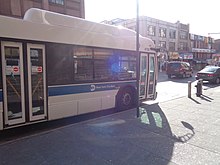
The Interborough Rapid Transit Company (IRT) was the private operator of New York City's original underground subway line that opened in 1904, as well as earlier elevated railways and additional rapid transit lines in New York City. The IRT was purchased by the city in June 1940, along with the younger BMT and IND systems, to form the modern New York City Subway. The former IRT lines are now the A Division or IRT Division of the Subway.
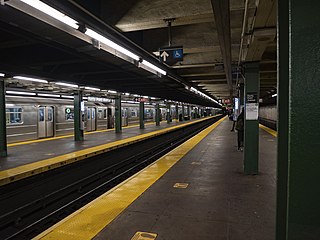
The Hunts Point Avenue station is an express station on the IRT Pelham Line of the New York City Subway, served by the 6 train at all times and the <6> train on weekdays in the peak direction. It is located at Hunts Point Avenue and Southern Boulevard in the Longwood neighborhood in the Bronx.

The 138th Street–Grand Concourse station, also signed as 138th Street–Mott Haven or simply as Mott Haven on station signage, is a local station on the IRT Jerome Avenue Line of the New York City Subway, located at the T-intersection of East 138th Street and the Grand Concourse in the Mott Haven neighborhood of the Bronx. It is served by the 4 train at all times except during rush hours in the peak direction, and the 5 train at all times except late nights.
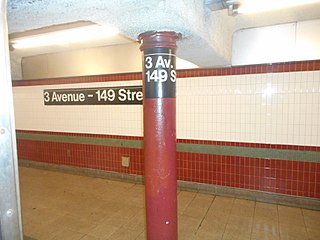
The Third Avenue–149th Street station is a station on the IRT White Plains Road Line of the New York City Subway. It is located at Third Avenue and East 149th Street in the Hub in the South Bronx adjacent to Mott Haven and Melrose. The station is served by the 2 train at all times and the 5 train at all times except nights. The station is the second-busiest in the Bronx and 59th overall, with around 6.768 million passengers using the station as of 2019.

The East 180th Street station is an elevated express station on the IRT White Plains Road Line of the New York City Subway. Located at the intersection of East 180th Street and Morris Park Avenue in the West Farms and Van Nest neighborhoods of the Bronx, it is served by the 2 and 5 trains at all times.

Melrose is a mostly residential neighborhood in the southwestern section of the New York City borough of the Bronx. It adjoins the business and one-time theater area known as The Hub. Melrose is rectangular-shaped, being bordered by Saint Anns Avenue on the east, 149th Street on the south, Park Avenue on the west, and 163rd Street to the north. Melrose Avenue and Third Avenue are the primary thoroughfares through Melrose.

Mott Haven is a primarily residential neighborhood in the southwestern section of the New York City borough of the Bronx. It is generally bounded by East 149th Street to the north, the Bruckner Expressway to the east and south, and the Harlem River to the west, although these boundaries are not precise. East 138th Street is the primary east–west thoroughfare through Mott Haven.

The Third Avenue–138th Street station is an express station on the IRT Pelham Line of the New York City Subway located at the intersection of Third Avenue and East 138th Street in the Bronx. It is served by the 6 train at all times and the <6> train during weekdays in the peak direction.

The 149th Street–Grand Concourse station is a New York City Subway station complex shared by the IRT Jerome Avenue Line and the IRT White Plains Road Line. It is located at East 149th Street and Grand Concourse in Mott Haven, Melrose and Concourse in the Bronx. The complex is served by the 2 and 4 trains at all times, and by the 5 train at all times except late nights.

The IRT Third Avenue Line, commonly known as the Third Avenue Elevated, Third Avenue El, or Bronx El, was an elevated railway in Manhattan and the Bronx, New York City. Originally operated by the New York Elevated Railway, an independent railway company, it was acquired by the Interborough Rapid Transit Company (IRT) and eventually became part of the New York City Subway system.
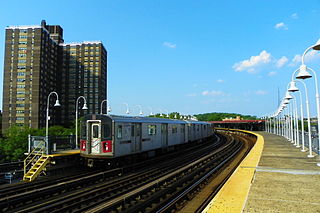
The White Plains Road Line is a rapid transit line of the A Division of the New York City Subway serving the central Bronx. It is mostly elevated and served both subway and elevated trains until 1952. The original part of the line, the part opened as part of the first subway was called the West Farms Division, and the extension north to 241st Street as part of the Dual Contracts was called the White Plains Road Line. Eventually, however, the two parts came to be known as the White Plains Road Line.

Third Avenue is a north-south thoroughfare on the East Side of the New York City borough of Manhattan, as well as in the center portion of the Bronx. Its southern end is at Astor Place and St. Mark's Place. It transitions into Cooper Square, and further south, the Bowery, Chatham Square, and Park Row. The Manhattan side ends at East 128th Street. Third Avenue is two-way from Cooper Square to 24th Street, but carries only northbound (uptown) traffic while in Manhattan above 24th Street; in the Bronx, it is again two-way. However, the Third Avenue Bridge carries vehicular traffic in the opposite direction, allowing only southbound vehicular traffic, rendering the avenue essentially non-continuous to motor vehicles between the boroughs.
The IRT Jerome Avenue Line, also unofficially known as IRT Woodlawn Line, is an A Division New York City Subway line mostly along Jerome Avenue in the Bronx. Originally an Interborough Rapid Transit Company-operated route, it was built as part of the Dual Contracts expansion and opened in 1917 and 1918. It is both elevated and underground, with 161st Street–Yankee Stadium being the southernmost elevated station. The line has three tracks from south of the Woodlawn station to the 138th Street–Grand Concourse station. The Woodlawn Line also has a connection to the Jerome Yard, where 4 trains are stored, just north of the Bedford Park Boulevard–Lehman College station.
The IRT Pelham Line is a rapid transit line on the New York City Subway, operated as part of the A Division and served by the 6 and <6> trains. It was built as part of the Dual Contracts expansion and opened between 1918 and 1920. It is both elevated and underground with Whitlock Avenue being the southernmost elevated station. It has three tracks from the beginning to just south of the Pelham Bay Park terminal. The Pelham Line also has a connection to Westchester Yard, where 6 trains are stored, just north of Westchester Square–East Tremont Avenue.

The Bx41 is a public transit line in New York City. It runs within the borough of the Bronx, operating along Melrose and Webster Avenue.

The Bx1 and Bx2 are two bus routes that run on the Grand Concourse in the Bronx, New York City. The routes, which are operated by the MTA Regional Bus Operations, also follow Sedgwick Avenue and Mosholu Parkway for a short distance at their northern end. As the numbers suggest, these were the first two bus routes in the Bronx.
Webster Avenue is a major north–south thoroughfare in the Bronx, New York City, United States. It stretches for 5.8 miles (9.3 km) from Melrose to Woodlawn. The road starts at the intersection of Melrose Avenue, East 165th Street, Brook Avenue, and Park Avenue in the neighborhood of Melrose, ending at Nereid Avenue in the neighborhood of Woodlawn. There are no subway lines along this thoroughfare, unlike the streets it parallels—Jerome Avenue, The Grand Concourse, and White Plains Road, which all have subway lines —but until 1973, Webster Avenue north of Fordham Road was served by the Third Avenue Elevated, served by the 8 train.

The 149th Street station was a station on the demolished IRT Third Avenue Line in the Bronx, New York City. It was located in "The Hub" in the South Bronx, at the intersection of 149th Street, Third Avenue, Willis Avenue, and Melrose Avenue. Opened as an express station in 1887 and later operating as the line's southern terminus, the station closed in 1973 and was demolished by 1977 due to political pressure in the area.
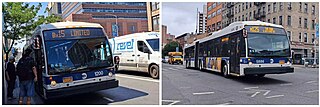
The Bx15 and M125 bus routes constitute the Third Avenue/125th Street Line, a public transit line in New York City. The Bx15 runs between Fordham Plaza and the Hub in the Bronx, running primarily along Third Avenue. The M125 runs between the Hub in the Bronx and Manhattanville in Manhattan, running along Willis Avenue in the South Bronx and along 125th Street in Harlem, Manhattan.




